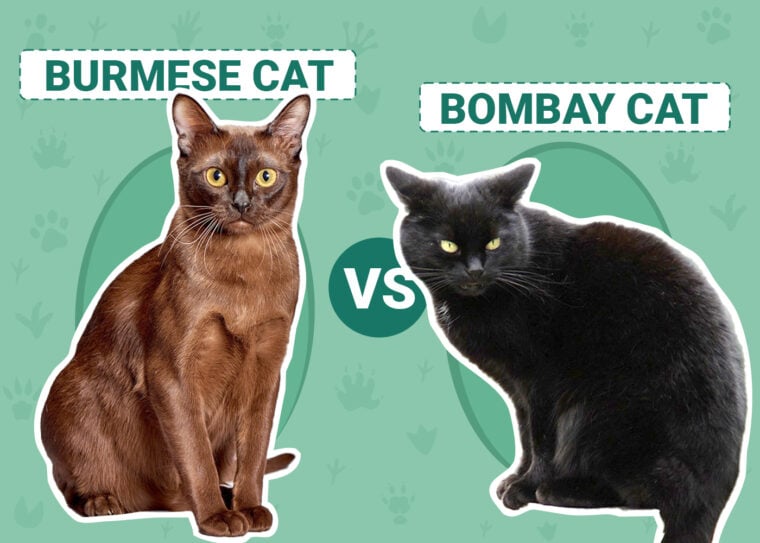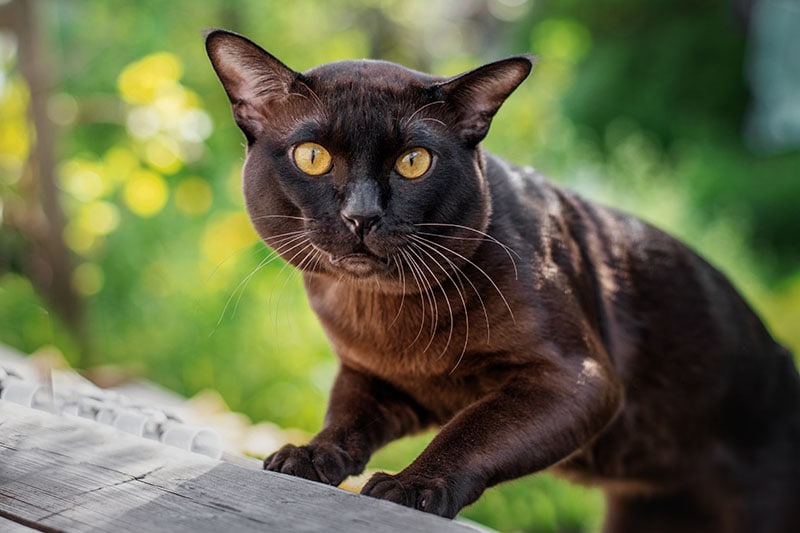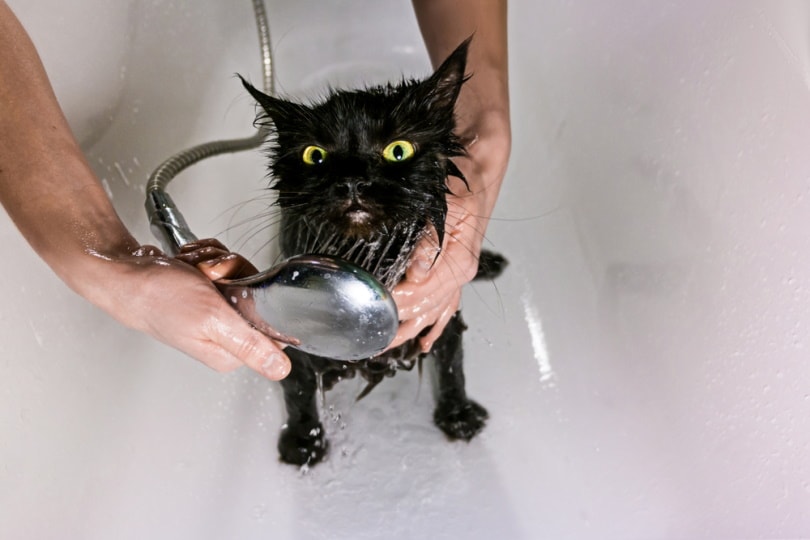
Before you commit to bringing a new feline companion home, you should learn everything about the breed’s personality, physical characteristics, and traits. Take, for example, the Burmese and Bombay cat breed.
The Burmese and Bombay cat breeds were recognized by TICA, or The International Cat Association, in 1979. Though both are popular breeds, there’s often confusion around them, seeing as one was bred from the other.
While they’re shorthairs and have several features in common, these cats have different looks, temperaments, and care requirements for their health and well-being. Keep reading to learn the differences between these outgoing cats, which will help you decide which you should choose as your family’s pet.
Visual Differences

At a Glance
Burmese Cat Overview

The Burmese cat breed has its origins in the country of Myanmar, which used to be known as Burma. The cat got its start in the US during the 1930s when a San Francisco doctor named Joseph Thompson brought home a small female cat with a brown coat from Southeast Asia.
Dr. Thompson named the feline Wong Mau and soon established the unique color characteristics through selective breeding with Siamese males. Initially, sepia was the breed’s accepted coat color before seal points started to appear within its ranks.
The unique-looking Burmese breed has grown in popularity across the US, and it was granted championship status by the Cat Fanciers’ Association in 1957.
Today’s Burmese cat has a silky coat with standard colors that range from sable to platinum and champagne, along with tortoiseshell hues. It’s a medium-sized cat with an affectionate personality and sociable nature, but one of its most striking features is its expressive eyes.
Personality / Character
Besides being highly intelligent and sociable, the Burmese cat breed is said to have several dog-like characteristics and tendencies. The sweet-natured feline is loving and affectionate towards their owners and will spend time with members of the family, often snuggled in their laps.
This solidly built breed craves attention and activity due to its high energy levels. It’s a curious feline that thrives on keeping itself occupied and enjoys learning new tricks. It does well in homes where there are children and other pets, including canines.
Due to their love for the company, Burmese cats don’t fare well when left alone and may become depressed or suffer separation anxiety. They’re also considerably chatty and communicative and will vocalize their intentions when they’re looking to grab your attention.

Health & Care
With the adequate provision of healthcare, the Burmese breed of cats is relatively long-lived and has a lifespan of beyond 12 years. Regular vet visits are essential to screen for common concerns such as congenital heart ailment and hypertrophic cardiomyopathy.
Other conditions the cat is susceptible to include glaucoma, calcium oxalate stones in the urinary tract, and feline hyperesthesia syndrome. While not prevalent, these disorders are screened for by reputable breeders when the cat reaches adulthood.
But you must be keen with feeding; if you don’t proportion the cat’s meals, it may suffer from obesity, which can cause other health problems like diabetes.
The Burmese cat prefers elevated warm spots for sleeping and lounging, and you should set up a cat tree in a warm space inside your home. While a hammock also works well if situated near a window, this feline won’t lounge all day as its playfulness and energy equals a high prey drive.
Purchase lots of toys, especially those that mimic rodents, birds, and other critters that make up a domestic feline’s traditional fare. Without a harness or catio, your Burmese may get lost if left outside unsupervised, and their human attachment often results in stress and anxiety.
Grooming
The Burmese cat has a sleek short coat, so very little brushing is required except for relaxed sessions that promote bonding. Despite minimal shedding, weekly grooming will keep this feline’s fur shiny and healthy while removing loose hair and dust.
Start regular teeth brushing and nail trimming from an early age to get your cat accustomed to these procedures. That’s essential, especially for oral hygiene, since this breed is susceptible to dental problems.

Suitable For:
Anyone that’s looking for a playful, energetic, loving, and affectionate cat will find the Burmese suitable, particularly if you’re after an indoor pet. Its demeanor makes it excellent for large families with children, seniors, and other household pets.
The Burmese are highly active and adaptable, which makes them suitable for small space dwellers such as apartments. However, you must provide it with a lot of activity for mental and physical stimulation; otherwise, be prepared for a vocal telling-off.
Bombay Cat Overview

The Burmese cat was bred with a domestic American shorthair to create the Bombay breed in 1965 by a breeder from Louisville, Kentucky named Nikki Hoener. She set out to create a muscular, heavy, and medium-sized cat, and the result was a sleek-coated feline resembling a black panther.
The cat turned out to be handsome with large, cute eyes and small pointy ears resembling those of the Burmese. In fact, most of the breed’s characteristics and traits are derived from its Burmese cat heritage, except for the solid black coat.
The CFA, or Cat Fanciers’ Association, recognized the Bombay cat (also known as the mini panther or black mamba) as a registered breed in 1970 and gave this breed championship status in 1976.
Personality / Character
Similar to its Burmese parentage, the Bombay cat is intelligent and highly social, and enjoys spending time around humans. It’s easygoing, playful, and active, constantly seeking the attention of its owner or family members.
This breed doesn’t fare well when left alone for long periods- it exhibits signs of separation anxiety, although it’s only vocal when necessary. While its vocalization is quiet and soft, this cat doesn’t shy away from your household commotion and will instead choose to sleep or stay near you all day.
Bombays are agile climbers and feature a strong, sturdy build, so you’ll provide high surfaces like a cat tree so they can spend time climbing. Toys and other play features are also necessary to keep your Bombay mentally stimulated and engaged, but it’s also vital for this breed that you offer one-on-one interaction.

Health & Care
The high energy levels of the Bombay cat carry on late into their adulthood, although they may slow down as they become seniors. It’s typically a healthy breed without specific congenital disorders and little to no predisposition to disease and illnesses.
However, it’s vital that you maintain their health and follow through on regular vet checkups so any ailments can be diagnosed and captured early. One common problem is hypertrophic cardiomyopathy, and a short snout can cause the cat to have respiratory issues.
Bombays tend to overeat and become obese like their Burmese progenitors, which may give rise to related illnesses if it’s not checked. Besides meals of a high-quality, balanced diet appropriately proportioned, you must ensure the Bombay cat gets adequate exercise.
Grooming
The black coat of the Bombay cat has sleek short fur that’s easy to maintain and requires little grooming except for routine brushing to remove loose hairs. Trimming the nails is also necessary, along with teeth brushing, which should be started early to create familiarity.

Suitable For:
Similar to the Burmese breed, Bombay cats’ friendly personalities make them suitable for large families where kids and other animals, including dogs, are present. It’s an indoor cat that’s lovable, social, active and doesn’t like loneliness, so they’ll prefer a house with seniors that can devote time to them.
Which Breed Is Right for You?
Bombays are directly descended from Burmeses through crossbreeding with American shorthair cats, so they’ve drawn significant traits and characteristics from one another, except for their coat colors.
Both cat breeds are very active, playful, and friendly, with high intelligence and sociability, although they require human attention to thrive. Burmese cats have an edge on their energetic curiosity, while the Bombay takes a more wait-and-see approach, slowing down as it gets older.
Both enjoy the same activities, namely climbing, exploring, and jumping. Your decision towards any of these two breeds will boil down to your personal preference or whether you prefer the coat color variation of the Burmese or the jet black of the Bombay.
See also:
- Rhodesian Boxer Mixed Dog Breed: Pictures, Care, Traits, & More!
- Rhodesian Boerboel Mixed Dog Breed: Pictures, Care Guide, Traits, & More!
Featured Image Credit: Top – Nattakorn Suphatheera, Shutterstock | Bottom – Viktor Sergeevich, Shutterstock







